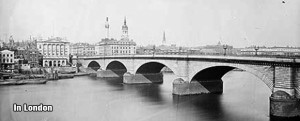 If you have ever wanted to see the sights in London but never had the chance to travel there, you can go to Arizona and see them instead – well, one of them, at least. In 1968 Robert P. McCulloch was looking for a unique attraction for his new retirement real estate development in Lake Havasu, Arizona. His real estate agent, Robert Plumer, learned that the London Bridge (from England) was for sale and convinced McCulloch to buy the bridge and move it to Lake Havasu. And what seemed to be “the craziest idea” at first, turned out to be a great idea.
If you have ever wanted to see the sights in London but never had the chance to travel there, you can go to Arizona and see them instead – well, one of them, at least. In 1968 Robert P. McCulloch was looking for a unique attraction for his new retirement real estate development in Lake Havasu, Arizona. His real estate agent, Robert Plumer, learned that the London Bridge (from England) was for sale and convinced McCulloch to buy the bridge and move it to Lake Havasu. And what seemed to be “the craziest idea” at first, turned out to be a great idea.
 The London Bridge originally took six years to construct – from 1825 to 1831 – and it spanned the River Thames in London, England. After over 130 years of use and population growth, it was determined that the London Bridge was “falling down” (sinking, actually) and could no longer handle the increased automotive traffic – because of this, it was closed in 1967. When the decision was made to build a new bridge, the old one was put up for auction. Robert P. McCulloch, the founder of Lake Havasu City in Arizona, submitted the winning bid of $2,460,000 to buy the bridge. He then went on to spend another $7,000,000 to dismantle, move, and reassembled the bridge in Arizona.
The London Bridge originally took six years to construct – from 1825 to 1831 – and it spanned the River Thames in London, England. After over 130 years of use and population growth, it was determined that the London Bridge was “falling down” (sinking, actually) and could no longer handle the increased automotive traffic – because of this, it was closed in 1967. When the decision was made to build a new bridge, the old one was put up for auction. Robert P. McCulloch, the founder of Lake Havasu City in Arizona, submitted the winning bid of $2,460,000 to buy the bridge. He then went on to spend another $7,000,000 to dismantle, move, and reassembled the bridge in Arizona.
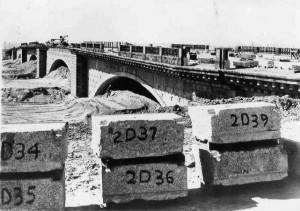 The granite for the famous bridge was quarried in Dartmoor, an area of moorland in south Devon, England, that is now Dartmoor National Park. While dismantling the bridge, it was discovered that code numbers had been put on each stone when it was originally built, much like the numbering system that would be used to reassemble the bridge in Arizona. Each stone was marked with numbers which indicated its position based on the arch span, the row, and then the stone’s position within that row, making assembly much easier.
The granite for the famous bridge was quarried in Dartmoor, an area of moorland in south Devon, England, that is now Dartmoor National Park. While dismantling the bridge, it was discovered that code numbers had been put on each stone when it was originally built, much like the numbering system that would be used to reassemble the bridge in Arizona. Each stone was marked with numbers which indicated its position based on the arch span, the row, and then the stone’s position within that row, making assembly much easier.
Looking for the most cost-effective way to get the bridge transported, Plumer made a special arrangement to move the pieces on a new cargo ship that a company was going to sail from Great Britain to the United States with no cargo, agreeing to pay the operating costs of the voyage, which was far less than the going rate of 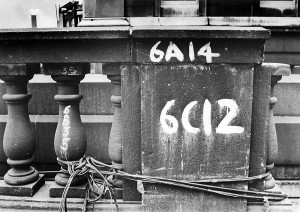 shipping. The stones were shipped overseas from England, through the Panama Canal, to Long Beach, California. From there, the final 300 miles of the old disassembled bridge’s 5,400-mile journey to its new home, had to be done by truck.
shipping. The stones were shipped overseas from England, through the Panama Canal, to Long Beach, California. From there, the final 300 miles of the old disassembled bridge’s 5,400-mile journey to its new home, had to be done by truck.
On September 23, 1968, a ceremony was held in Arizona, which included the Lord Mayor of London Gilbert Inglefield, who laid the cornerstone that began the reconstruction project. Robert Beresford, a civil engineer from Nottingham, England, was in charge of reconstructing the bridge in Lake Havasu City. He used the original plans drawn by the bridge’s original designer, John Rennie, as a guideline for reconstruction, and also drew sketches of his own during different phases of the massive rebuild project.
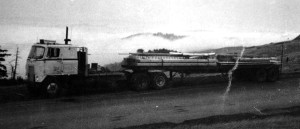 When the work of putting the bridge back together was finished, they now had to get water under it. The bridge was not built over a river – it was built on land – and then a one mile channel, the Bridgewater Channel Canal, was dredged from one part of Lake Havasu to another, creating an island. Once the sand was removed, the water was then diverted under the bridge, and then back to the lake. On October 10, 1971 the bridge was opened amidst much fanfare – about 50,000 spectators enjoyed a parade, fireworks and entertainment. Celebrities like Lorne Greene from Bonanza and the Lord Mayor of London were there, as well.
When the work of putting the bridge back together was finished, they now had to get water under it. The bridge was not built over a river – it was built on land – and then a one mile channel, the Bridgewater Channel Canal, was dredged from one part of Lake Havasu to another, creating an island. Once the sand was removed, the water was then diverted under the bridge, and then back to the lake. On October 10, 1971 the bridge was opened amidst much fanfare – about 50,000 spectators enjoyed a parade, fireworks and entertainment. Celebrities like Lorne Greene from Bonanza and the Lord Mayor of London were there, as well.
After relocating the bridge to Lake Havasu, McCulloch’s real estate development campaign accelerated. It was reported that over 2,700 flights carried in some 37,000 prospective buyers to the airport on the island for free. These flights lasted until 1978. Today, Lake Havasu City is the playground of the southwest, and a popular destination for snowbirds – retirees looking for warmer weather during the winter.
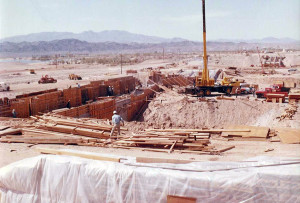 The city offers many benefits, like 360 days of sunshine, state-of-the-art medical facilities, great schools, and several modern parks, as well as scenic and well-maintained beaches. It’s a favorite destination for events such as weddings and honeymoons, and features the deep blue lake with miles of pristine beaches and beautiful mountain views. A day on the lake or a night on the town, you won’t be disappointed.
The city offers many benefits, like 360 days of sunshine, state-of-the-art medical facilities, great schools, and several modern parks, as well as scenic and well-maintained beaches. It’s a favorite destination for events such as weddings and honeymoons, and features the deep blue lake with miles of pristine beaches and beautiful mountain views. A day on the lake or a night on the town, you won’t be disappointed.
My inspiration for this story about the famous bridge that moved from the rainy climate of London to the desert of Arizona is my “sis” Heather Hogeland. One day we were talking about places we’ve been, and she told me about riding with her dad, Bob Warren, when he was hauling a load of stone to the job site for the famous bridge. As an added twist, her dad, Bob, was also born in England and remembers seeing the bridge when it crossed the River Thames. I’m sure when he was a young lad in England he never would have dreamed that he would one day haul two loads of stone for that bridge, on a truck, from California to Arizona – but that is exactly what he ended up doing!
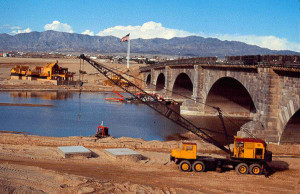 Where Bob was born in London made him a “Cockney” – anyone born within earshot of the bells of St. Mary-le-Bow is defined as a Cockney. St. Mary-le-Bow is a historic church in London on the main east–west thoroughfare, Cheapside. Located a half mile from the church via King William Street, the bells could be heard easily at the bridge. Today, anyone with a London accent is likely to be called a Cockney. Bob and his family moved to Canada when he was ten years old, and he decided shortly after getting there that he wanted to lose the Cockney accent. In 1956 the family moved to California, where he became a U.S. citizen in 1968.
Where Bob was born in London made him a “Cockney” – anyone born within earshot of the bells of St. Mary-le-Bow is defined as a Cockney. St. Mary-le-Bow is a historic church in London on the main east–west thoroughfare, Cheapside. Located a half mile from the church via King William Street, the bells could be heard easily at the bridge. Today, anyone with a London accent is likely to be called a Cockney. Bob and his family moved to Canada when he was ten years old, and he decided shortly after getting there that he wanted to lose the Cockney accent. In 1956 the family moved to California, where he became a U.S. citizen in 1968.
When Bob was 25 he started his dream job – driving a bus for the Trailways Bus Company. That lasted for three
years, until one day, after being dispatched to Fresno, California, when he had to shut down due to a lack of hours. For doing this, he was fired. At the time, a friend knew someone who needed a driver, asked Bob if he wanted to drive a truck. By the time Trailways called Bob to ask him to come back, he had a truck driving job and, as they say, the rest is history.
Later, after buying his own truck, while working for Contractors Cargo Carriers, he was dispatched on a load to haul stones that were part of the London Bridge from Long Beach, California, to Lake Havasu City, Arizona. At just eleven years old, traveling in the truck with her dad on one of these hauls, Heather remembers asking him why anyone would want to put a bridge in the desert where there was sand and no water. What a cool memory of time on the road with her dad. Of course, Heather, along with her husband Roger, would later go on to become a successful owner-operator, as well.
In addition to the other “connections” in this story, there is also a 10-4 Magazine connection. Back in August of 1999, Bob and his wife Doreen and their chameleon-colored 1999 Volvo 770 (it was one of those paints that changed colors in different lighting) graced the cover of the magazine. Married for over 50 years, Doreen sadly passed away in 2005. Their Volvo truck was one of only two Volvos to ever grace the cover of 10-4 Magazine in 22 years!
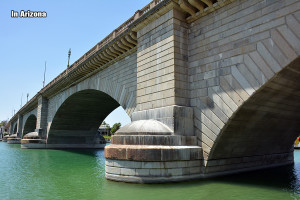 I have to thank Heather for going to Lake Havasu and taking some great pictures for us to use with this story. After doing the research and talking to Heather and Bob, I am anxious to go there and visit the bridge myself (I have never seen it in person). There are so many neat things to do and places to see out there, but we often overlook them. I am glad that McCulloch saved this piece of history, and even happier that it is around for so many to enjoy every day. A bridge “connects” things together, and this story certainly had a lot of “connections” this month.
I have to thank Heather for going to Lake Havasu and taking some great pictures for us to use with this story. After doing the research and talking to Heather and Bob, I am anxious to go there and visit the bridge myself (I have never seen it in person). There are so many neat things to do and places to see out there, but we often overlook them. I am glad that McCulloch saved this piece of history, and even happier that it is around for so many to enjoy every day. A bridge “connects” things together, and this story certainly had a lot of “connections” this month.
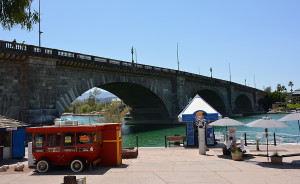 On the north end of the bridge there is a plaque that says: “In Grateful Memory of Robert P. McCulloch, whose purchase of the London Bridge in 1968 saved it for the enjoyment and use of prosperity.” Today, the London Bridge is the second largest tourist attraction in Arizona – second only to the Grand Canyon. I guess that “crazy idea” wasn’t so crazy after all.
On the north end of the bridge there is a plaque that says: “In Grateful Memory of Robert P. McCulloch, whose purchase of the London Bridge in 1968 saved it for the enjoyment and use of prosperity.” Today, the London Bridge is the second largest tourist attraction in Arizona – second only to the Grand Canyon. I guess that “crazy idea” wasn’t so crazy after all.

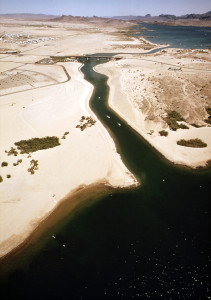
2 Comments
Thank you Kim for the article, I loved reading about the bridge so if Heather was 12 when Dad hauled some of the bridge I was 8-9 so yea I dont remember too much except when he took us to the site and told us what was going to be done there. Now an Arizona resident and avid Havasu fan, Each time we travel down through the channel and under the bridge, my kids sing london bridges falling down, something my Mom, had done with them for years. I love the old picture of my Dad’s old international, that truck sure went through a bunch of stuff. I went to the bus stop one day to see it had sunk in the mud from the storm overnight, and ran home crying Daddy Daddy your truck is sunk. Keep up the good work and if you get out here I’ll take you for a boat ride through the channel :)
Best story I found on it, great writing!